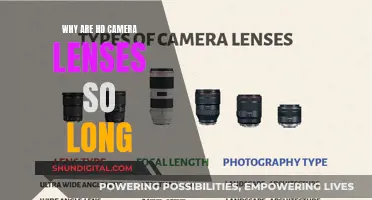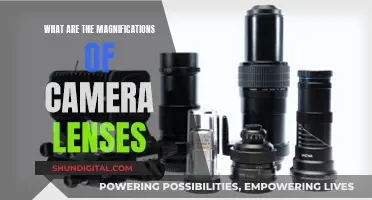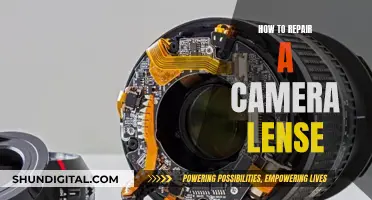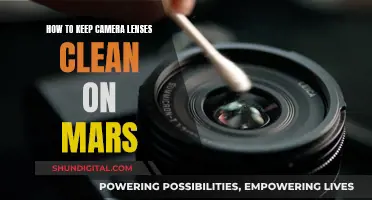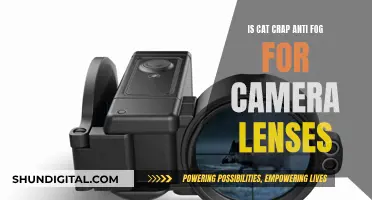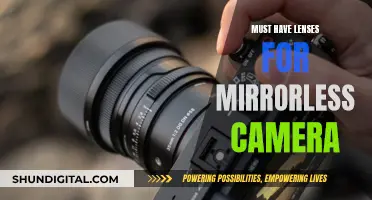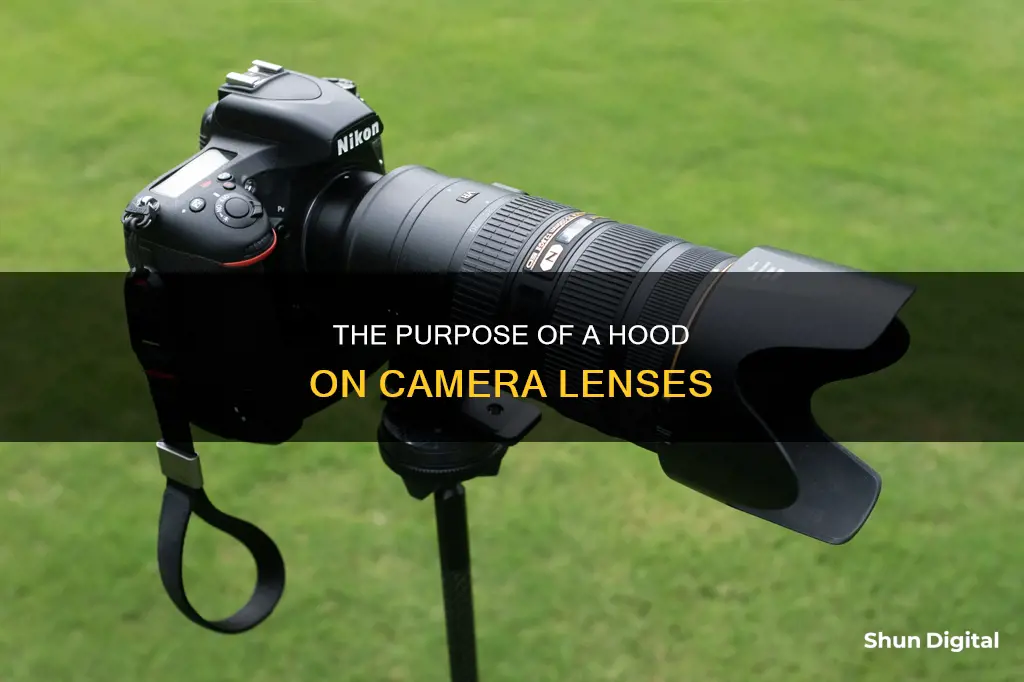
A lens hood is an accessory that attaches to the front of a camera lens. It is usually made of plastic or metal, and it can make a huge difference in the quality of your images. The main purpose of a lens hood is to reduce the amount of light coming into the lens, allowing you to control lens flare and maintain clarity and contrast in your images. They can also help protect your lenses from damage, fingerprints, and the elements.
What You'll Learn

Blocking Unwanted Light
A lens hood is an essential accessory for photographers, often overlooked by beginners and even some professionals. It is a simple device that attaches to the front of your lens and blocks unwanted light from entering the lens from odd angles, causing lens flare and reducing image quality.
The main purpose of a lens hood is to block or reduce the amount of unwanted light entering the lens, acting as a visor and preventing lens flare and glare in your photos. This is more likely to happen when using a low-quality filter or an old one that doesn't have advanced anti-glare coatings. While lens flares can be interesting elements in a photo, they can be distracting, especially when they cover the subject or most of the scene.
Lens hoods are particularly useful when shooting outdoors or in any situation with strong light sources, such as direct sunlight, bright street lamps, or studio strobes. They help to reduce the amount of light entering the lens from sharp angles, preventing light waves from bouncing around inside the lens and causing flare and glare.
By blocking unwanted light, lens hoods improve image quality by increasing contrast and clarity. They prevent flares and strong glares from washing out the image, reducing contrast and causing discolouration. With a lens hood, you can ensure that your lens gets a good, clear view of the scene, resulting in sharper and more vibrant images.
Additionally, lens hoods can be useful at night to block unwanted artificial light from causing lens flare. They are also beneficial when shooting in rough and rugged locations, providing some protection if you drop your camera or bump it into something.
However, it is important to note that lens hoods can sometimes catch the wind, causing camera shake and blurry images, especially when using a telephoto lens. In such cases, it is recommended to remove the lens hood.
Differentiating Camera Lenses: A Guide to Spotting the Differences
You may want to see also

Protecting the Lens from Damage
Lens hoods are a great way to protect your lens from accidental damage. They act as a "bumper bar on a car", providing an additional layer of protection against accidental impacts, scratches, fingerprints, rain, snow, dust, and other debris. While a lens hood may not save your lens if you drop your camera, it will likely absorb most of the impact, potentially saving you from having to replace the lens.
Lens hoods are particularly useful when shooting in harsh weather conditions, preventing the lens from getting caked in snow and ice, or rained on. They also help to keep the lens clear of fingerprints and other smudges, which can ruin a shot.
Some photographers prefer to use UV filters or lens caps to protect their lenses, but a lens hood is an external layer of protection that won't interfere with the lens glass. It's also a good idea to combine a lens hood with a lens filter for maximum protection.
Lens hoods are especially useful for telephoto lenses, where filters and front elements can be expensive. The hoods tend to be deep, providing ample protection from the elements.
In addition, lens hoods can protect your lens from sustaining damage that could stop it from working properly, such as cracked glass. They can also protect the front glass element of your lens from scrapes and cracks if the lens accidentally swings and collides with something head-on.
While lens hoods are not a guarantee that your lens will be protected from all harm, they certainly provide peace of mind and an extra layer of security.
Motorized Telescoping Lenses: Are They Reliable Camera Companions?
You may want to see also

Shielding the Lens from the Elements
- Protection from physical damage: A lens hood acts as a "bumper bar" for your lens, providing an additional layer of protection from accidental impacts, scratches, fingerprints, and other sources of damage. It is the first thing that will hit the ground if you drop your camera, and while it may break upon impact, it is much cheaper to replace than a lens.
- Protection from the weather: A lens hood can shield your lens from rain, snow, and dust, allowing you to take photos in harsh weather conditions without damaging your equipment.
- Protection from smudges: A lens hood can help keep the front element of your lens free from fingerprints and other oily smudges.
Unlocking the Power of Macro Camera Lenses
You may want to see also

Preventing Smudges on the Lens
- Avoid touching the lens with your fingers. Oils from your skin can leave fingerprints and smudges on the lens surface. Always handle your lens with care and avoid touching the front glass element.
- Use a lens hood to protect the lens from accidental impacts, scratches, and fingerprints. It serves as a barrier and can help prevent smudges caused by direct contact with the lens.
- Clean your lenses as infrequently as possible. Every cleaning session carries the risk of scratching the lens or damaging its coating. Only clean your lens when necessary, using a blower brush or camel hair lens brush to remove dust and dirt, followed by a lens cloth or lens tissue to wipe away smudges. Avoid using tissue paper, eyeglass tissues, or rubbing alcohol, as these can damage the lens coating.
- Store your camera in a protective case with the lens cap on when not in use. This will help prevent dust, dirt, and other contaminants from accumulating on the lens, reducing the need for frequent cleaning.
- Use a lens filter in conjunction with a lens hood for added protection. A UV filter, for example, can help shield the lens from dust, dirt, and scratches while also reducing ultraviolet light.
- Be cautious when using lens hoods in windy conditions, especially with telephoto lenses. The hood may catch the wind and cause camera shake, resulting in blurry images. In such cases, consider removing the lens hood or using an alternative method to block unwanted light.
The Ugly Truth: Camera Lenses and Distortion
You may want to see also

Increasing Contrast and Clarity
A lens hood is an essential accessory for your camera lens, and it does much more than make your gear look more professional. It can improve your image quality by increasing contrast and clarity.
Lens hoods block unwanted light from entering your camera lens, which helps to control lens flare and maintain clarity and contrast in your images. When lens flares and strong glares hit your lens, they wash out your image and reduce contrast and overall image quality.
Lens hoods prevent stray light from entering the lens, ensuring that it gets a good, clear view of a scene. This results in images with better contrast and clarity.
You can use a lens hood in most circumstances, but they are especially useful when:
- Your subject is backlit
- You're shooting near strong light sources, like the sun, street lamps, or car lights
- You're shooting at night near street lamps, cars with their lights on, or buildings
- You're doing a long shoot and don't have time to keep putting a lens cap on
- You're using an off-camera flash or any bright, off-camera light source that creates a lens flare
While lens hoods are beneficial in most situations, there are a few times when you may want to remove the lens hood:
- If you want to create a flare effect in your photo
- If the lens hood is showing up in your photos
- If you're using certain filters or accessories on your lens that prevent you from attaching a lens hood
- If the lens hood is catching the wind and causing blurry photos
Mounting Still Lenses: PL-Mount Cinema Camera Compatibility
You may want to see also
Frequently asked questions
A lens hood is an accessory that attaches to the front of your camera lens, usually made of plastic or metal.
A lens hood blocks unwanted light from entering the lens, reducing lens flare and improving image quality. It also adds an extra layer of protection to the lens.
You should use a lens hood in most circumstances, especially when you want to avoid lens flare and protect your camera lens.
Yes, there are a few situations where you may not want to use a lens hood. For example, if you want to create a lens flare effect in your photo, or if you're using certain filters or accessories that prevent you from attaching a lens hood.
Choose a lens hood that is compatible with your particular lens model. You can store your lens hood by reversing it on your lens or by stacking multiple hoods together.


